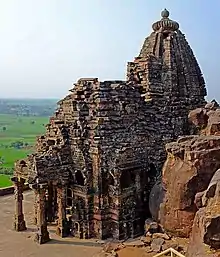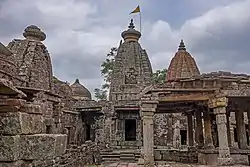Jain temples, Vidisha
Vidisha is considered to be Puranakshetras Jain tirtha. The Jain temples are located in Vidisha district in state of Madhya Pradesh, India. According to Jain belief, Vidisha is the birthplace of Shitalanatha, the tenth tirthankar. Here the first 108 feet elevated temple with all Tirthankaras with Shitalanatha as the principal deity is under construction.[1]
| Jain temples, Vidisha | |
|---|---|
 Maladevi temple | |
| Religion | |
| Affiliation | Jainism |
| Deity | Tirthankar |
| Festivals | Mahavir Jayanti |
| Location | |
| Location | Vidisha, Madhya Pradesh |
| Geographic coordinates | 23°39′32.1″N 78°06′49.1″E |
| Architecture | |
| Style | Gupta, Māru-Gurjara, Mughal |
| Creator | Gupta, Pratihara dynasty |
| Date established | 4th to 5th century |
| Completed | 10th century |
| Temple(s) | 14 + 1 cave |
| Part of a series on |
| Jainism |
|---|
 |
|
|
Jain cave
According to Jain belief, Vidisha is one of the first places where the Jain images were worshipped. The earliest of these are two Jain caves of Udayagiri. Only a torso remains of one cave, and this torso is now exhibited in an open-air museum.[2]
Cave 20 is the only cave in the Udayagiri Caves complex is dedicated to Jainism. It is on the northwestern edge of the hills. At the entrance is the image of the Jain Tirthankara Parshvanatha sitting under a serpent hood. The cave is divided into five rectangular rooms with stones stacked, the total length of 50 feet (15 m) that is about 16 feet (4.9 m) deep.[3]
Jain temples
Bada Mandir
Bada Mandir is one of the fourteen Jain temples present in Vidisha. The temple is built in Mughal architecture. The bada mandir consists of a miraculous Jain idol which is considered to be older than the temple.[2]
Bajramath Jain temple
Bajramath Jain temple is situated in Gyaraspur and dates back to the 10th century. This temple enshrines three garbhagrihas with the temple is fully decorated with Jain sculptures.[4] The temple was earlier a Brahmical temple dedicate to Surya but was transformed to a Jain temple which is evident from carvings of Hindu God Surya, Shiva and Vishnu on door jambs.[5] All three shrines of this temple are now occupied with idols of tirthankaras.[6][7] The temple houses a finely carved five–hooded idol of Suparshvanatha.[8]
Maladevi temple
Maladevi temple dates back to the 9th century. This is a rock-cut temple built in Pratihara style. The temple was initially a Brahmical temple but later converted to a Jain worship site. The temple is rich with carvings of tirthankaras, yakshi, and yaksha. The temple consists of entrance porch, mandapa garbhagriha and shikhara.[9] The temple is dedicated to Adinatha.[10][11] The Maladevi temple is considered one of the best examples of its collection of varied Jain sculptures.[12][13] The temple houses finally carved idol of Shantinatha in lotus position with symbol of deer and four armed yaksha and yakshi.[14]
Gadarmal Devi temple
Gadarmal Devi temple dates back to the 9th century. The architecture of this yogini temple is a fusion of Pratihara and Parmara styles. It is built similar to Teli ka Mandir in Gwalior fort. This temple houses both Hindu and Jain idols.[15] The temple is made of sandstone with seven small shrines surrounding the main shrine.[16]
Pataria Jain temples
Pataria Jain temples was built in the 9th century in Badoh city. These are a cluster of 25 temples with the main shrine surmounted with shikharas; the other shrines have a flat roof, shikharas, and dome.[17][18]
Restoration
In 1930, Gwalior state stepped up to conserve Maladevi temple.[19] All of the monuments in Vidisha are protected by Archaeological Survey of India.[20]
Gallery
 Pataria Jain temple
Pataria Jain temple Bajramath Jain temple
Bajramath Jain temple.jpg.webp) Carvings of Vishnu on wall of Bajramath Jain temple
Carvings of Vishnu on wall of Bajramath Jain temple.jpg.webp) Image of Adinatha inside Bajramath Jain temple
Image of Adinatha inside Bajramath Jain temple
.jpg.webp) Detailed carving on pillar of Maladevi temple
Detailed carving on pillar of Maladevi temple
See also
| Wikimedia Commons has media related to Jain temples, Vidisha. |
References
Citations
- Dainik Bhaskar & 108 feet temple.
- Titze & Bruhn 1998, p. 13.
- Cunningham 1880, pp. 53–54.
- ASI & Bajramath Temple.
- Mishra 2010, p. 77.
- Ayyar 1987, p. 16.
- Madhya Pradesh Tourism & Temples of Madhya Pradesh, p. 24.
- Shah 1987, p. 141.
- ASI & Maladevi Temple.
- Mishra 2010, p. 76.
- Madhya Pradesh Tourism & Temples of Madhya Pradesh, p. 23.
- Jain 2009, p. 283.
- Ghurye 2005, p. 39.
- Shah 1987, p. 154.
- ASI & Gadarmal Temple.
- Madhya Pradesh Tourism & Temples of Madhya Pradesh, p. 26.
- Jain 1972, p. 431.
- ASI & Badoh Jain Temple.
- India Times & Gyaraspur.
- ASI & Vidisha.
Sources
- Cunningham, Alexander (1880), Report of Tours Bundelkhand and Malwa 1874–1875 and 1876–1877, Archaeological Survey of India, Vol. 10, ASI, Government of India,
 This article incorporates text from this source, which is in the public domain.
This article incorporates text from this source, which is in the public domain. - Titze, Kurt; Bruhn, Klaus (1998). Jainism: A Pictorial Guide to the Religion of Non-Violence (2 ed.). Motilal Banarsidass. ISBN 81-208-1534-3.
- Ayyar, Sulochana (1987), Costumes and Ornaments as Depicted in the Sculptures of Gwalior Museum, Mittal Publications, ISBN 9788170990024
- Shah, Umakant Premanand (1987), Jaina-Rupa Mandana: Jaina Iconography, 1, India: Shakti Malik Abhinav Publications, ISBN 81-7017-208-X
- Mitra, Swati (2010), Buddhist Circuit in Central India: Sanchi, Satdhara, Sonari, Andher, Goodearth Publications, ISBN 9789380262055
- Temples of Madhya Pradesh. Goodearth Publications. ISBN 9789380262499.
- Jain, Arun Kumar (2009), Faith & Philosophy of Jainism, Gyan Publishing House, ISBN 9788178357232
- "Maladevi Temple". Archaeological Survey of India.
- "Bajramath Temple". Archaeological Survey of India.
- "Gadarmal Temple". Archaeological Survey of India.
- "Badoh Jain Temple". Archaeological Survey of India.
- "Vidisha". Archaeological Survey of India.
- Jain, Kailash Chand (1972), Malwa Through The Ages, Motilal Banarsidass, ISBN 9788120808249
- "Vidisha, the country's first 108 feet elevated temple with all Tirthankars". Dainik Bhaskar. 17 April 2019. Retrieved 28 July 2019.
- Ghurye, G.S. (2005), Rajput Architecture, Popular Prakashan, ISBN 9788171544462
- Kumar, Arjun (20 October 2010). "Gyaraspur a small town which takes you back in time". India Times. Retrieved 3 August 2019.